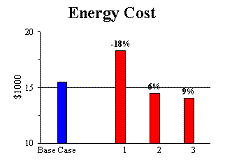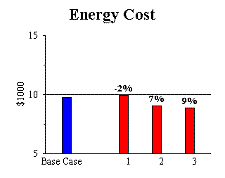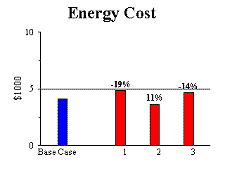
Reference Publication: McIlvaine, J., Mallette, M., Parker, D., Callahan, M., Lapujade, P., Floyd, D., Schrum, L., Stedman, T., Cumming, B., Maxwell, L., Salamon, M., "Energy-Efficient Design for Florida Educational Facilities," Prepared for the Florida Department of Education, Tallahassee, FL., September, 2000. Disclaimer: The views and opinions expressed in this article are solely those of the authors and are not intended to represent the views and opinions of the Florida Solar Energy Center. |
Energy-Efficient Design for Florida Educational Facilities
Janet McIlvaine, Michele Mallette, Danny Parker, Michael
Callahan, Philippe Lapujade, David Floyd, Lynn Schrum,
Ted Stedman, Brian Cumming, Larry Maxwell, Milt Salamon
Florida
Solar Energy Center (FSEC), R. Douglas Stone Associates, Inc.,
Spacecoast Architects, Technical Editor
FSEC-CR-1682-00
Section I: Schematic
Design
Overview
During the Schematic Design phase, design teams should:
Schematic design decisions have a lasting impact on building energy use and the effectiveness of energy conservation measures (ECMs). At this point in the design process, the design team should loosely decide which ECMs are likely to be used and plan for their implementation.1. Establish financial parameters.
2. Select energy conservation strategies.
3. Incorporate optimal building orientation.
4. Consider advantageous building configuration.
Establish Financial Parameters
Design decisions should be based on realistic expectations. The energy savings data in this manual (given in kBtu/SqFt) can be coupled with current utility, materials, and installation costs to establish a simple payback or life cycle cost. Life cycle savings for each ECM appear in Conclusions, Tables 1-3. Additionally, an economic optimization based on life cycle savings appears in the Conclusions section. There, we also include optimization analysis showing the highest performance group of technologies as well as the predicted most cost effective package of options.
When referring to the cost evaluations in this manual, design teams need to consider whether or not the Base Case Building (described in Appendix A) is similar to the building in question and make allowances for any differences. As much detail as possible regarding the energy savings and cost data used to produce the economic evaluations in this manual have been included in Appendix A. If a school design closely matches the Base Case Buildings (described generally in the Introduction section and in detail in Appendix A), the economic analysis provides a good basis for decision making.
During Schematic Design, an acceptable length of payback or other
financial criterion needs to be established to aid the design team in selecting
ECMs. When design teams have a clear idea of how much money can be allocated
to ECMs and how quickly it must be recouped, selecting ECMs for a specific
project will be simplified. A required period of payback may have already
been established by the facilities office of the district or campus.(3)
Select Energy Strategies
To achieve the greatest success, design teams should select energy strategies early. Planning should begin during Schematic Design for those energy strategies that depend on the relationship of the building to the sun's path. For example, if the design team waits until Design Development to try incorporating a daylighting strategy, then the basic building orientation and configuration may not support effective daylighting.
This need for early planning holds true not only for strategies related to orientation but also for items such as energy management systems and more efficient Heating, Ventilating, and Air Conditioning (HVAC) equipment. These strategies should be selected early so that implementation, financing, and maintenance issues can be fully explored, and appropriate spatial or relational allowances in the site and floor plan can be made during Schematic Design.
To properly select an approach, the design team needs to understand the typical energy use characteristics of educational facilities in Florida.
- What are the major uses of energy in school facilities?
- What are the components of those uses?
Energy End-uses
The major uses of energy, or end-uses, are related to the services and associated equipment that consume energy. Statistics compiled for the Florida Energy Office (SRC, 1992) show that the major energy end-uses in educational facilities statewide are HVAC equipment and electrical lighting equipment (Figure 3). The rest of the consumed energy goes to other various end-uses such as water heating, kitchen equipment, office equipment, etc.
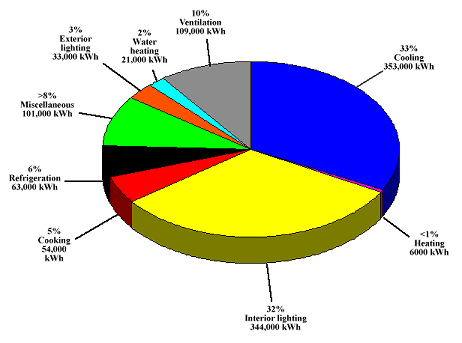
Figure 3. Energy end-use in a typical Florida educational facility.
Energy Loads
The components, or loads, of the end-uses are those forces that induce the devices or equipment to use energy. For example, heat produced by occupants is a load on the HVAC system, an end-use. Designers with a clear understanding of energy use characteristics in educational facilities can select more rewarding strategies by targeting major end-uses and their loads.
Targeting HVAC and lighting achieves the highest energy savings; so throughout this manual many ECMs are discussed in terms of their ability to reduce the consumption of these two key end-uses and their associated loads. The components of the HVAC and lighting loads are discussed below.
HVAC Loads: Principally, HVAC systems in Florida use energy to perform three functions: provide ventilation, supply cool conditioned air, and control moisture. The major loads on the HVAC system are heat and moisture generated by occupants, lights, and equipment (Figure 4). These internally generated loads can often be effectively reduced.
Other externally gained loads include heat radiated from the sun to interior surfaces through glazing, heat conducted to the interior by exterior surfaces, and infiltration of unconditioned outside air through the building envelope. Outside air introduced as ventilation air also makes a large contribution to the air conditioning load. Air conditioning consumption can be reduced by either reducing these loads or selecting more efficient HVAC equipment.
| Type of Load |
Component of |
% of Total Load |
| Internal Heat and Moisture Loads |
Occupants Lights Equipment |
29 15 6 |
| External Heat and Moisture Loads |
Walls Roof Glass conduction Glass radiation Underground surfaces Infiltration/Ventilation |
1 2 2 7 2 36 |
Source: DOE2.1E Simulation Analysis (see Appendix
A).
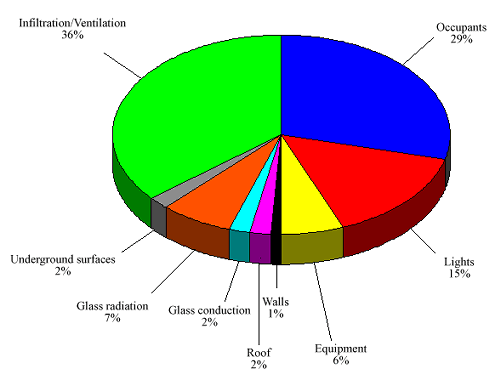
Figure 4. Peak air conditioning load characteristics for
a Base Case Classroom Building.
The design team has two fundamental methods for achieving low air conditioning consumption:
- Minimize the HVAC loads and the size of the HVAC equipment.
- Maximize the efficiency of the HVAC equipment.
During Schematic Design, the design team can plan ahead for a low-consumption HVAC system by:
- planning for heat-rejecting envelope finishes and/or assemblies
- minimizing east- and west-facing glazing
- committing to a high efficiency HVAC system
- committing to a low-consumption/high-efficiency lighting strategy
- carefully considering an effective ventilation system
- committing to energy efficient equipment (copiers, computers, printers, etc.)
Lighting Loads: Educational facilities have an undeniable need for visual comfort, which is strongly influenced by the distribution and quality of light. A major portion of the electrical lighting load comes from the demand for general lighting throughout the school. Exterior lighting, task lighting, accent lighting and exit signs, and miscellaneous lighting make up the balance of the lighting load.
Lighting systems in educational facilities directly use about 32% of the total annual electrical consumption. Additionally, they are one of the largest loads on the HVAC system.
When the lighting load decreases, the HVAC load decreases too. This dual role in energy consumption makes lighting ECMs especially attractive. With lighting, design teams can reduce the HVAC and lighting end-uses simultaneously.
Generally the design team has two methods for achieving efficient lighting systems:
- Minimize the run-time of the lighting system.
- Maximize the efficiency of the lighting system.
During Schematic Design, designers can lay the foundation for
reducing lighting system run-time by planning for daylighting and occupancy
controls. This begins with Optimal Orientation and Building
Configuration, is developed with Glazing Selection in Design Development,
and is completed with Electronic Dimming Ballast in System Design.
Even without the benefit of a well-planned daylighting scheme, high-efficiency
lighting systems and automated lighting controls produced results that
ranked among the top performers studied.
Attitude
In reality, any energy conserving strategy selected will ultimately
need the attention of every design team member because, from the energy
perspective, buildings are systems. All the energy-use elements are interconnected.
Everyone on the design team should be aware of the energy goals of the
team and understand how his/her contribution to the design relates to those
goals.
| Energy Intensity |
Energy Cost |
Cooling Capacity |
Electric Consumption |
Gas Consumption |
Incremental First Cost |
Energy Cost Savings |
Simple Payback |
||
| Classroom Building | kBTU/sqft | $ | Tons | kWh | Therms | $ | $ | Years | |
| 1 | Base Case | 44 | 15,481 | 46 | 186,239 | 103 | 0 | 0 | 0 |
| Non-optimal Orientation | 45 | 15,726 | 47 | 190,449 | 126 | 0 | -245 | 0 | |
| Energy Intensity | Energy Cost | Cooling Capacity | Electric Consumption | Gas Consumption | Incremental First Cost | Energy Cost Savings | Simple Payback | ||
| Administration Building | kBTU/sqft | $ | Tons | kWh | Therms | $ | $ | Years | |
| Base Case | 42 | 9735 | 25 | 122,670 | 60 | 0 | 0 | 0 | |
| 1 | Non-optimal Orientation | 44 | 9937 | 25 | 125,679 | 74 | 0 | -202 | 0 |
| Energy Intensity | Energy Cost | Cooling Capacity | Electric Consumption | Gas Consumption | Incremental First Cost | Energy Cost Savings | Simple Payback | ||
| Multipurpose Building | kBTU/sqft | $ | Tons | kWh | Therms | $ | $ | Years | |
| Base Case | 16.15 | 4068.63 | 20 | 509,177 | 418.93 | 0 | 0 | 0 | |
| 1 | Non-optimal Orientation | 17.94 | 4366.11 | 21 | 554,251 | 503.52 | 0 | -297 | 0 |
Objective: Maximize daylighting potential by orienting major glazing areas, or window, to face south and north. Minimize solar heat gains by having as little wall area and glazing as possible face east and west.
Considerations: In summer, east- and west-facing walls and windows receive direct solar radiation for a longer period each day than south-facing walls. North and south facades receive diffuse and reflected solar radiation for longer periods than the east- and west-facing walls. Diffuse and reflected solar radiation causes less glare and contains less infrared radiation, or heat. Additionally, the shallow sun angles in the east and west sky prove very difficult to shade. From an energy perspective, a good schematic site plan provides north- and south-facing glazing, limits east- and west-facing glazing, and minimizes east- and west-facing walls.
Although some perceive daylighting as expensive, it can often be a very low cost strategy when planned from the beginning. There is also persuasive evidence that daylighting improves the learning environment. By making the decision to orient most windows to face north and south, half of the daylighting challenge is met and costs for window shading are effectively minimized.
To fully maximize daylighting success, follow up with Window Shading and Glazing Selection strategies during Design Development. This will improve the quality of daylighting in spaces with south-facing glazing by reducing glare and localized overheating. Also follow up with daylight responsive lighting controls in System Design to ensure that available natural light will actually reduce lighting system energy use.
ECM Options:
1. Optimal Orientation
1. Optimal Orientation
Building orientation determines the buildings relationship with the sun's path. This in turn determines solar gain characteristics of the building and the daylighting potential. If a building's long or major axis is parallel to the east-west axis, then the major facades and major glazing areas of the building will face north and south. This constitutes Optimal Orientation (Figure 5).
 |
 |
Figure 5. Align the long axis of a building with the east-west axis, and position major glazing areas to face north and/or south.
Glazing that faces north will provide the highest quality of daylight and the least amount of heat gain, because the solar radiation does not come directly from the sun but is reflected off of surfaces and diffused through the atmosphere. North-facing glazing places little burden on the HVAC system and provides pleasant light appropriate for classrooms, administrative offices, libraries, and cafeterias.
Glazing facing south, on the other hand, can receive solar radiation directly from the sun. Southern sun brings with it intense heat which causes localized overheating when focused in a small area such as an office, conference room, or the perimeter of a classroom. Additionally, direct southern sun is more likely to cause disability glare (light reflecting from work surface into eyes) than the diffuse or reflected northern sun. Still, this north-south exposure is preferable to the east-western exposure since the south-facing facade will receive direct solar radiation for a smaller portion of the day. The southern exposure of Optimal Orientation can be much more effectively shaded with exterior elements than the east or west.
Non-optimal orientation, or aligning the long building axis with the north-south axis, carries two penalties. First is the thermal penalty from wall and glazing solar heat gains. East- and west-facing facades receive direct solar radiation for more hours during the day than a south facade and at lower angles (Figure 6). Second is the daylighting penalty. When sunlight comes from a low angle (as it does from east and west), exterior shading becomes very difficult and occupants have to use interior shades to reduce glare and localized overheating. Unfortunately, with interior blinds or curtains the heat, or infrared, portion of sunshine is not stopped from entering the interior space but the visible, or light, portion is interrupted. Therefore, the window does not provide much natural illumination, rendering any daylighting strategy ineffective for the time period that the blinds are closed. Meanwhile, the space still suffers most of the thermal gains. Depending on the shape of the building, that time period will likely be from just after noon until the end of school on the west. And on the east, it will be from mid-morning to just before noon. This would likely reduce daylighting savings from electronic dimming ballasts, for example, by roughly 40%. (These shading issues are discussed further in Window Shading strategy in the Design Development Section). Exterior shading redirects solar radiation, but more importantly does not disable the daylighting scheme the way interior shading devices do.
|
Azimuth |
Dec |
Jan/Nov |
Feb/Oct |
Mar/Sept |
April/Aug |
May/July |
June |
| 60-90 90-135 135-180 180-225 225-270 270-300 |
8-9 (0-20) 9-12 (20-38) 12-4 (38-20) 4-5 (20-0) |
7-8 (0-25) 8-12 (25-42) 12-3:30 (42-25) 3:30-5 (25-0) |
7-9 (0-38) 9-12 (38-50) 12-2:30 (50-38) 2:30-5:30 (38-0) |
6:30-10 (0-52) 10-12 (52-62) 12-2 (62-52) 2-6 (52-0) |
6-7 (0-25) 7-11 11-2 12-1 2-4 4-6 |
5:30-9 (0-50) 9-11 11-12 12-1 1-3 3-6:30 |
5:30-9 (0-50) 9-11:15 11:15-12 12-12:45 12:45-2 2-6:30 |
Note: 90o Azimuth = due East, 180o Azimuth = due South, 270o Azimuth = due West
Figure 6. Sun azimuth and altitude (alt) angles for latitude 28o (Orlando) throughout the day and year.In the absence of a daylighting scheme, simulations (Figure 7) reveal that non-optimal orientation (#1) has a significant impact (2-3%) on annual energy consumption due largely to radiant heat gain through glazing. If coupled with an advanced glazing (#2) or a high-efficiency lighting system (#3), this penalty can be overcome, however the localized overheating and glare challenges associated with east and west facing glazing will remain.
|
|
|
|
| 1 Non-optimal Orientation 2 Non-optimal Orientation, Double Spectrally Selective Glazing 3 Non-optimal Orientation, T-8 Lamps, Electronic Dimming Ballast |
Figure 7. Simulation data shows a penalty of about 2% for selecting
non-optimal orientation (#1) compared to the optimally oriented Base Case
Building. This penalty can be overcome with other options, but glazing
in this position (#2, #3) challenges the success of daylighting strategies.
Strategy: Building
Configuration
Objective: Configure spaces for the best use of daylighting and to support an efficient HVAC strategy.
Considerations: During Schematics Design, spaces are laid out in general positions to serve educational needs. Try to position spaces which will benefit most from daylighting on the north and south perimeters of buildings where they can make the best use of north- and south-facing glazing. These spaces include classrooms, offices, library, and meeting rooms.
Follow up this planning with Window Shading and Glazing Selection during Design Development and Daylight Dimming Ballasts in System Design. Also during Schematic Design, think ahead to how the facility might operate, and group spaces that have similar daily and annual occupancy schedules. Follow this up in System Design by providing an HVAC system to allow a reduction in conditioning when the area is unoccupied, or otherwise providing control over the area as a unit.
ECM Options:
1. Designate daylighting zones on north and south perimeters.
2. Cluster spaces with similar annual occupancy schedules.
3. Cluster spaces with similar daily occupancy schedules.
4. Consider buffer zones on east and west perimeters.
5. Consensus Recommendations.
1. Designate daylighting zones on north and south perimeters
List those spaces which, in terms of quality of environment will benefit most from daylighting. Most school spaces can reap benefits from properly designed daylighting because it can reduce electrical lighting. Moreover, some spaces can be especially enhanced with natural light, such as libraries, art rooms, classrooms, cafeterias, etc.
Once a list has been established of high priority daylighting spaces, assign those spaces to the north and south perimeters where daylighting opportunities should be best. These will become the daylighting zones. If Non-Optimal Orientation is used for a building, assign those spaces with the highest priority for daylighting to the north and south perimeters and plan to select a superior glazing during Design Development for the east- and west-facing windows used for daylighting.
Daylighting zones (Figure 8) refer to an area containing a source of daylight (window, skylight, etc.) in which the lighting system may be dimmed or turned off when daylighting is sufficient. The depth of a daylighting zone will be determined by the size and position of glazing in a space. A daylighting zone may be only a portion of a larger space, such as a cafeteria or classroom, or it may encompass whole spaces such as offices or break rooms. When a daylighting zone is only a portion of a larger space, the lighting fixture controls servicing the zone function should be independent of the rest of the controls.

Figure 8. Daylighting zones on the north and south perimeters of buildings
offer the best opportunity for daylighting.
A reasonable daylighting zone can reach 10 to 15 feet into a space, so spaces smaller than that, such as duplicating rooms or small work rooms, do not make full use of the daylighting potential. Be sensitive, as well, to areas where daylighting may be undesirable or only beneficial if strictly controlled, such as projection or darkroom spaces. These spaces will not make best use of daylighting, but can be positioned advantageously by occupying the east and west perimeters where glazing should be minimal.
2. Cluster spaces with similar annual occupancy schedules.
Determine which spaces will be used year-round and which will be used only sporadically. Both of these types of spaces produce variances in the HVAC operating schedule for spaces occupied for the length of the regular school year.
Spaces with long operating schedules such as administrative offices, summer school classrooms, athletic facilities, or rooms used for weekend meetings -- may require full conditioning when other spaces are vacant and require only humidity control. Plan for this need by placing these spaces closest to the source of chilled water (Figure 9) or conditioned air. This cuts down on heat gains while the coolant/cooled air is in transit from the chiller or air handler to the point of delivery. Alternatively, give these spaces a separate system. Remember to provide space for mechanical equipment dedicated to one or more spaces that have a variant occupancy schedule.

Figure 9. Buildings/spaces to be used year-round can be located closest
to the central mechanical space (Administration and Summer Instruction Classroom
Buildings) or alternatively given a separate system (multipurpose building)
to reduce heat gains to distribution lines (ducts or chilled water pipes) during
the variant occupancy period.
If a space with a long occupancy schedule is grouped with spaces that have a comparatively short occupancy schedule, the less occupied spaces may be conditioned unnecessarily at times. While designers can not predict the use of every space in a school, a workable schedule can be drawn from similar schools by considering how the school facility is used when school is not in session and what annual activities occur during the summer or other unoccupied periods of the year.
3. Cluster spaces with similar daily occupancy schedules.
Group spaces expected to have the same daily operating schedules into one area and plan to provide, during System Design, a means of reducing conditioning and lighting in that area as a whole (i.e., using an energy management system or variable volume distribution) when it is unoccupied. This will help ensure that only the energy required for the actual load is used. Consider providing room for a separate mechanical system to serve spaces with a daily occupancy schedule that varies widely from the rest of the facility (Figure 10).

Figure 10. Buildings/spaces with daily occupancy schedules differing
from the facility in general can be grouped near each other and provided with
a separate system.
These spaces might include an auditorium used for community assemblies, night school rooms, athletic facilities, and before-and-after school program spaces.
For variable volume or other staged systems locate the central plant or air handler closest to the spaces with longest occupancy schedules, to minimize losses in transit from the point of supply to the point of delivery.
4. Consider buffer zones on the east and west perimeters.
Consider the east and west perimeter spaces as thermal buffer zones. Position spaces on the unglazed spaces of the east and west perimeter that stand to gain little from daylighting, such as those with a short occupancy schedule, limited use, storage cabinets, etc.
Solar radiation absorbed by east- and west-facing exterior walls is conducted through the building envelope and becomes part of the cooling load, so place unconditioned spaces (such as janitorial rooms, staircases, supply closets, outdoor storage, etc.) on the unglazed west and east perimeters to buffer the conditioned space (Figure 11). When the absorbed heat is conducted into these buffer zones instead of into conditioned space, the cooling load from solar radiation is diminished.

Figure 11. Buffer zones on the east and west perimeters diminish the
effect of exterior heat gain. They are generally impractical of the long east
and west perimeters of buildings with non-optimal orientation.
Spaces with after school occupancy will also benefit from being positioned on the building's eastern perimeter which will receive no direct sun at that time. Conversely, spaces occupied only in the morning, such as kindergarten classrooms or other part-day program spaces will benefit from locations on the building's west perimeter where they will receive little direct sun during occupied hours.
The effectiveness of buffer zones as an HVAC load reduction option is minimized by the fact that only about 1-2% (see Figure 4) of the peak HVAC load comes from heat gained from walls. Therefore, implement buffer zones wherever practical and convenient, but do not consider it a major component of an energy conservation plan.
Concentrate during schematic design on properly orienting the building and laying the foundation for daylighting and determining which strategies and Energy Conservation Measures (ECMs) will be incorporated during design development.
For the design of a low energy facility, the only Building Configuration ECM that can be considered as crucial is the designation of daylighting zones. Making this effort will provide a good foundation for a daylighting scheme.
If optimal orientation and daylighting zones are not feasible for a given facility, it is advisable to pursue those strategies and ECMs not related to daylighting: Glazing Selection, Enhanced Envelope, Efficient Lighting System Components, Occupancy Sensors, and Efficient HVAC Systems.
Daylighting has been shown to be important not only for energy related characteristics, but also in the students abilities to learn. A recent study in Seattle, Washington, Orange County, California, and Fort Collins, Colorado quantified daylighting effects on student learning. Students with the most daylighting in the classrooms progressed faster on math and reading tests and may play a role in better student attendance, improved mood and behavior (Heschong Mahone Group, 1999).
Clustering spaces for advantageous HVAC operation is a good energy design practice idea, however, it is not critical to the development of a low energy building design. Likewise, buffer zones are a good practice but not an essential part of low energy design. They may be more important in small buildings. Concentrate during schematic design on properly orienting the building and laying the foundation for daylighting and determining which strategies and ECMs will be incorporated during design development.
3. The Florida DOEd currently requires Life Cycle Cost analysis only for the HVAC system.

